Cactus has become one of the most searched plants when it comes to useful and worthy gardening. One of the toughest plants in the world, Cactus or Cacti in the plural, has been one of the plant species that every gardener looks ahead to.
In today’s post, we thought of checking out the popular types of Cactus in Texas. The city of Texas is known for a good range of Cacti, and if you are a seasoned gardener, you will find it an excellent option for giving a new look to your garden.
What is Cactus?
The Cactus is a plant of the family Cactaceae. The family has over 127 different genera and 1750 known species of the plant. The name cactus has been derived from the words of Theophrastus for a spiny plant.
The Cactus belongs to more than 10000 species of succulent plants. Not only among succulent plants, but Cactus rules the roost among almost all houseplants. Cactus as the name is inspired by the Latin term that was further derived from the ancient Greek way of life. During those days, Kaktos was a spiky plant that was entirely found in Sicily.
The Cactus is quite popular on the American continent. Right from North America to South America, you will ideally find hundreds of varieties of Cacti. However, Mexico boasts of a huge share of the best ever Cacti ever. In fact, Cactus as a plant has been considered to be equivalent to the native of Mexico.
How to Identify Cactus?
Cactus has been one of the most common plant species among the succulents. In fact, you will be able to identify the Cactus relatively quickly when you compare it to the other succulents. It has been one of the extremely recognisable genera among the succulent plants family.
The two prime characteristics that can be helpful in identifying the Cactus without any issues as such. The Stem and the Areoles are what would be helpful in efficiently identifying the Cactus in the right spirit.
As for the stem, you will find that most of the Cacti come with a green, leafless and spiny stem. In essence, the Cactus has the leaves transformed into the stem and come with a bulbous body that helps it retain and store water.
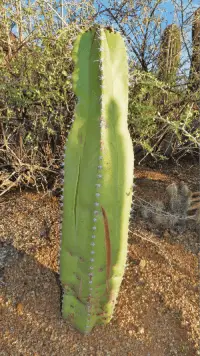
Once you have found the information about the stem, the next hint in identifying the Cactus is to look at the areoles. The areoles refer to the wooly and hairy part from where the spine emerges. You would find this structure only in Cactus and not in any other succulent.
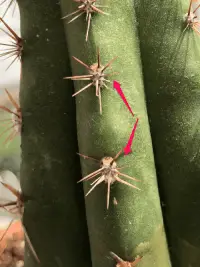
If you are looking to find the exact options for the positive identification of Members of the Cactus Family, it may be worthwhile to check out the gardening assistants who can help you pick the best options.
How to Grow Cactus?
Cactus has been one of the most widely used plants for indoor planting. The unique look, a longer life and more comfortable care are a few factors that would make it one of the best options for an indoor gardening. Growing a cactus plant should be extremely easy and simple enough.
A Cactus does need full sunlight for almost all the species and genera. For the potted varieties of Cacti, it would be a good idea to go with the small and medium sized cacti. Cactus needs the soil that has faster draining. Using the normal potting may not be a good choice in this case. You need to go with the special cactus specific potting soils and pots. You may also use the standard potting soil and use it in a 1:4 ratio to make it thinner.
Most of the cacti, when purchased are already growing, and it should not take anything more than simply digging a hole and planting them. You should wait for at least two to three weeks before watering your pot.
The fertilisers are quite specially designed for the Cactus. The standard fertilisers may not work well with the cacti. You should focus on a proper watering. In the late summer and winter, it is advisable to reduce the watering to an ultimately none.
Types of Cactus in Texas
If you are in Texas, you will find that Texas is the home for a huge range of different types of cacti. Let us check out a few of the best options for the best types of Cactus in Texas. There are different types of succulents in Texas, and it will be a good idea to understand them in a more positive manner.
| Type | Habitat | Range of availability | Form | Flowers |
| Ariocarpus fissuratus (Living Rock) | Limestone ridges, low levels | West Texas, | Flattened disc, always solitary, bearing triangular, warty, overlapping tubercles | Pale pink to purple, in fall or early winter. |
| Coryphantha Nickelsiae (Nickels Cactus | Desert scrubland and limestone terraces, low levels | Far south Texas | Small globes; solitary or cluster forming | Pale yellow with white bands, during late summer |
| Coryphantha Macromeris (Nipple Beehive) | Gravel flats and hillsides | Southeast New Mexico, the Big Bend area of west Texas, and far south Texas | Small, tuberculate stems, forms clusters, | pink to purple coloured, bloom in late summer |
| Cylindropuntia Imbricata (Tree Cholla) | grassland, scrubland, woodland, hillsides | South Colorado, all across New Mexico, west Texas, far southeast Arizona, west Oklahoma, west Kansas | Tall, branched clumps | Pink, violet |
| Echinocereus Chloranthus (Brown coloured Cactus) | Gravely slopes | South New Mexico, west Texas | Single, occasionally branched | Red to brown blooms in early to mid-spring |
| Ferocactus Hamatacanthus (Texas Barrel cactus) | Limestone hillsides and cliffs | West and South Texas along the Rio Grande, and Otaro County, southern New Mexico | Single, may form clusters at times. | Yellow and reddish underneath |
| Cylindropuntia leptocaulis (Christmas Cholla) | Scrubland, grassland, canyon sides | Arizona, New Mexico, Texas, southwest Oklahoma | Low shrub | Greenish yellow |
Living Rock Cactus

The name itself gives it out. Not exactly rock, but it gives the appearance of a rock. It simply sticks to the land and provides you with a flat and circular shape. You would also find the scaly look all the more interesting.
The rugged stone-like appearance is indeed one of the exciting options that should ideally make it one of the exciting options ever. These are spineless cacti and grow very much close to the ground. You would find it flowering during the in fall or early winter making it the only time when the cactus would be visible.
Nickel’s Cactus
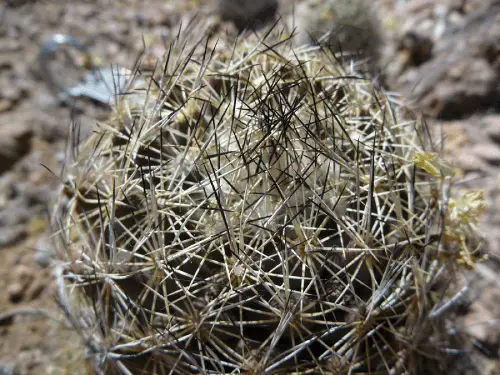
You would find them just as brown balls with pointy needles. The plant has a little greenery, and you will ideally find the pointy needles are designed to protect it. Once again, the plant does not grow larger, but stays relatively close to the ground.
The Cactus is named after Anna Nickels, a Texas cactus enthusiast. The species is quite rare but is not yet endangered as it is. This is one of the smallest of the cacti, and it grows lesser than 3 inches in diameter and just around 4 inches in height. It can grow either single or can form a group.
Nipple Beehive Cactus
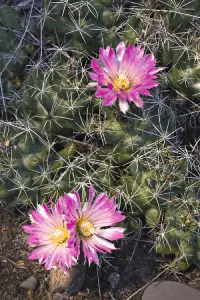
The Cactus derives its name from the small nipple-like ball. These were the modified leaves. These balls are further protected by the sharper and pointy needles. These needles form a small ball that somehow resembles a beehive.
It is quite commonly grown in the shady regions. Stems generally do not grow beyond a height of 6 inches. Purple flowers and green fruits are what would sum up the Cactus. The spins point out in a range of different directions.
Tree Cholla
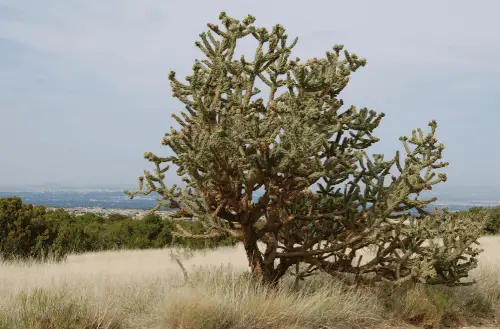
The Cactus resembles a tree and is found in a huge range of environments. It can either grow in the deserts or even in the mountains at the height of 6000 feet. One of the huge varieties of the cactus family, it grows to be the size of a shrub. It even reaches the size of being called a tree.
The Cactus has the pointy spikes that make it stand out like a cactus plant. The plant has violet flowers that further develop into orange fruits that stay on the tree for over a few months. The plant can reach as high as 8 feet.
Brown Flowered Cactus

The Cactus does have greenery, but most of the greenery is covered by the brown coloured spikes. The Cactus looks almost similar to Nipple Beehive cactus. It belongs to the robust spine cactus species, but the flowers further make it one of the beautiful options ever.
The Cactus can grow to around ten inches tall. Of course, the Cactus is limited to a few certain locations. The plant is covered by dense brown, red or white spines and that would definitely make it one of the excellent choices ever. The variable colour further enhances your experience.
Texas Barrel Cactus
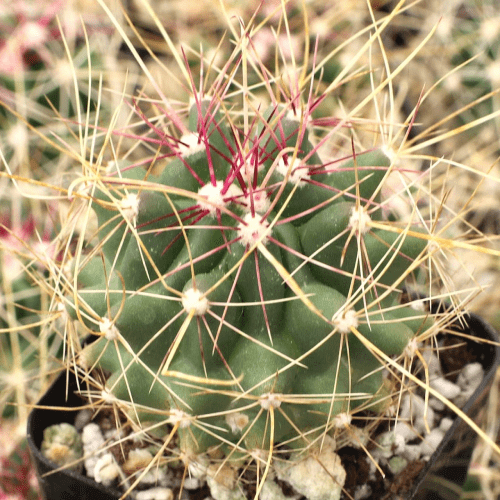
The Cactus is grown in New Mexico. The variety is one of the widespread species found in and around Texas. It can grow to up to 6 inches long. Sometimes, you would find the plant growing to up to 12 inches in length.
One of the best parts with the cactus species is that it is tolerant to frost. You would find the spines that range across multiple colours such as white, red, yellow or intermediate shades.
Christmas Cholla
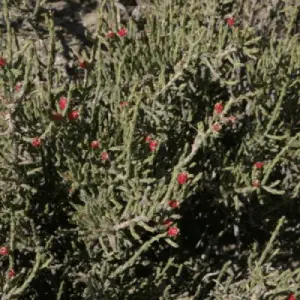
The Cactus has thick and sharp spines can reach a length of up to two inches. They can detach easily on contact. Some of the plants can be quite spineless. It forms low shrub of size up to 4 feet tall. It is found to be growing in areas of elevations of up to 5000 feet.
The fruit is quite small and yellowish in colour. The fruits remain on the tree till around midwinter. That is precisely why they are called Christmas Cholla. You would find it across southwest states in the US.
These were the most popular cactus found in Texas, but these are not only out there, there are so many, and few more of them, I am putting below:
- Robust Spine Beehive Cactus (Coryphantha Robustispina)
- Eagle Claws (Echinocactus Horizonthalonius)
- Horse Crippler (Echinocactus Texensis)
- Scarlet Hedgehog Cactus (Echinocereus Coccineus)
- Lace Hedgehog Cactus (Echinocereus Reichenbachii)
- Ladyfinger Cactus (Echinocereus Pentalophus)
- Fendler’s Hedgehog (Echinocereus Fendleri)
- Green Strawberry Hedgehog (Echinocereus Enneacanthus)
- Lace Hedgehog Cactus (Echinocereus Reichenbachii)
- button cactus (Epithelantha micromeris)
- Cob beehive cactus (Escobaria tuberculosa)
- Big Bend prickly pear (Grusonia aggeria)
- Chihuahuan fishhook cactus (Glandulicactus uncinatus)
- Strawberry hedgehog cactus (Echinocereus stramineus)
- Nylon hedgehog cactus (Echinocereus viridiflorus)
- rat-tail pincushion cactus (Mammillaria pottsii)
- Chenille prickly pear (Opuntia aciculata)
- Rio Grande prickly pear (Opuntia aureispina)
- Purple prickly pear (Opuntia azurea)
- Warnock’s fishhook cactus (Echinomastus warnockii)
- Arizona barrel cactus (Ferocactus wislizeni)
- Common beehive cactus (Escobaria vivipara)
- Devil cholla (Grusonia Emoryi)
- Graham’s club cholla (Grusonia grahamii)
- Arizona fishhook cactus (Mammillaria grahamii)
- lacespine pincushion cactus (Mammillaria lasiacantha)
- Little pincushion cactus (Mammillaria meiacantha)
- rat-tail pincushion cactus
Final Words
Growing Cactus in Texas or elsewhere may not be a challenging task if you can follow a few precautions and understand the right requirements of a cactus species. The cactus identification tips and the information on how to grow Cactus as outlined in the above discussion should ideally help you pick the right options.
Check out the different species of Cactus in Texas and share your inputs about the experience with us.
FAQs on Types of Cacti in Texas
Is Picking Cactus illegal in Texas?
If you are picking cacti on the private land, you need to get a permission from the land owner. Taking anything from a private property is considered to be vandalism and stealing. If you like the Cactus in Texas, you can take a legal permission and pick them.
Can You Eat Texas Cactus?
Each part of the Cactus is edible. If you find it odd, you will find it one of the staple diets in most regions across Mexico. Cactus forms a significant part of the Texas cuisine.
How Much Does Texas Barrel Cactus cost?
Price for the Texas Barrel cactus range from $8 to $400. There may be better bargains depending on the size.
